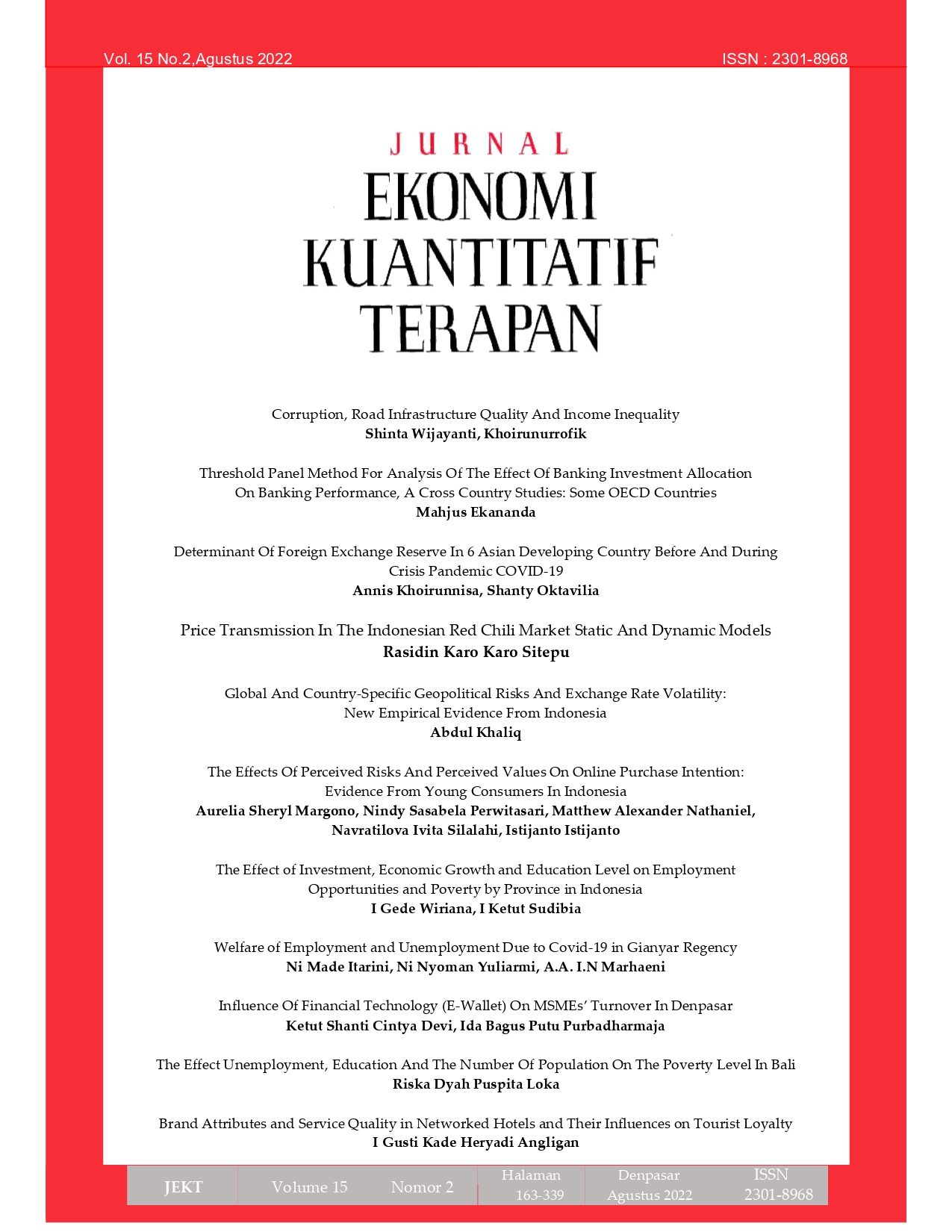Global and Country-Specific Geopolitical Risks and Exchange Rate Volatility: New Empirical Evidence from Indonesia
Abstract
This paper investigates the conditional predictability of geopolitical risks (GPR) on the rupiah-dollar exchange rate volatility, using 447 monthly observations spanning January 1985 to March 2022. The paper utilizes asymmetric GARCH (1,1) combined with various asymmetric GARCH models, including the integrated GARCH (I-GARCH), the exponential GARCH (E-GARCH), and the threshold GARCH (T-GARCH), and the power asymmetric GARCH (A-PARCH). This study finds convincing evidence that GPRI has a consistent effect on exchange rate volatility, either symmetric GARCH models or asymmetric GARCH models. Interestingly, the global geopolitical risks (GPR) heterogeneously affect the exchange rate volatility of Indonesia. These empirical findings imply that the rupiah-dollar exchange rate volatility is more vulnerable to domestic GPRI than global GPR.
Downloads
References
Aysan, A. F., Demir, E., Gozgor, G., & Lau, C. K. M. (2019). Effects of the geopolitical risks on Bitcoin returns and volatility. Research in International Business and Finance, 47, 511–518. https://doi.org/10.1016/j.ribaf.2018.09.011
Baillie, R. T., Bollerslev, T., & Mikkelsen, H. O. (1996). Fractionally integrated generalized autoregressive conditional heteroskedasticity. Journal of Econometrics, 74(1), 3–30. https://doi.org/10.1016/S0304-4076(95)01749-6
Balcilar, M., Bonato, M., Demirer, R., & Gupta, R. (2018). Geopolitical risks and stock market dynamics of the BRICS. Economic Systems, 42(2), 295–306. https://doi.org/10.1016/j.ecosys.2017.05.008
Bank Indonesia. (2022). Statistik Ekonomi Keuangan Indonesia. Retrieved April 1, 2022, from https://www.bi.go.id/id/default.aspx
Bartsch, Z. (2019). Economic policy uncertainty and dollar-pound exchange rate return volatility. Journal of International Money and Finance, 98, 102067. https://doi.org/10.1016/j.jimonfin.2019.102067
Barunik, J., Krehlik, T., & Vacha, L. (2016). Modeling and forecasting exchange rate volatility in time-frequency domain. European Journal of Operational Research, 251(1), 329–340. https://doi.org/10.1016/j.ejor.2015.12.010
Benavides, G., & Capistrán, C. (2012). Forecasting exchange rate volatility: The superior performance of conditional combinations of time series and option implied forecasts. Journal of Empirical Finance, 19(5), 627–639. https://doi.org/10.1016/j.jempfin.2012.07.001
Bentes, S. R. (2015). Forecasting volatility in gold returns under the GARCH, IGARCH and FIGARCH frameworks: New evidence. Physica A: Statistical Mechanics and Its Applications, 438, 355–364. https://doi.org/10.1016/j.physa.2015.07.011
Bollerslev, T. (1986). Generalized autoregressive conditional heteroskedasticity. Journal of Econometrics, 31(3), 307–327. https://doi.org/10.1016/0304-4076(86)90063-1
Bush, G., & López Noria, G. (2021). Uncertainty and exchange rate volatility: Evidence from Mexico. International Review of Economics and Finance, 75(March), 704–722. https://doi.org/10.1016/j.iref.2021.04.029
Caldara, D., & Iacoviello, M. (2022a). Geopolitical Risk Index. Retrieved April 1, 2022, from https://www.policyuncertainty.com/gpr.html
Caldara, D., & Iacoviello, M. (2022b). Measuring Geopolitical Risk. In American Economic Review (Vol. 212). https://doi.org/10.1257/aer.20191823
Caporale, G. M., Menla Ali, F., & Spagnolo, N. (2015). Exchange rate uncertainty and international portfolio flows: A multivariate GARCH-in-mean approach. Journal of International Money and Finance, 54, 70–92. https://doi.org/10.1016/j.jimonfin.2015.02.020
Chen, L., Du, Z., & Hu, Z. (2020). Impact of economic policy uncertainty on exchange rate volatility of China. Finance Research Letters, 32(109), 1–5. https://doi.org/10.1016/j.frl.2019.08.014
Chiang, T. C. (2021). Geopolitical risk, economic policy uncertainty and asset returns in Chinese financial markets. China Finance Review International, 11(4), 474–501. https://doi.org/10.1108/CFRI-08-2020-0115
Ding, Q., Huang, J., & Zhang, H. (2021). The time-varying effects of financial and geopolitical uncertainties on commodity market dynamics: A TVP-SVAR-SV analysis. Resources Policy, 72(January), 102079. https://doi.org/10.1016/j.resourpol.2021.102079
Engle, R. F. (1982). Autoregressive Conditional Heteroscedasticity with Estimates of the Variance of United Kingdom Inflation. Econometrica, 50(4), 987. https://doi.org/10.2307/1912773
Engle, R. F., & Bollerslev, T. (1986). Modelling the persistence of conditional variances. Econometric Reviews, 5(1), 1–50. https://doi.org/10.1080/07474938608800095
Glosten, L. R., Jagannathan, R., & Runkle, D. E. (1993). On the Relation between the Expected Value and the Volatility of the Nominal Excess Return on Stocks. The Journal of Finance, 48(5), 1779–1801. https://doi.org/10.1111/j.1540-6261.1993.tb05128.x
Hoque, M. E., Zaidi, M. A. S., & Hassan, M. K. (2021). Geopolitical uncertainties and malaysian stock market returns: Do market conditions matter? Mathematics, 9(19), 1–16. https://doi.org/10.3390/math9192393
Hui, H. C. (2020). Does Geopolitical Risk Affect Exchange Rates? The Case of Indonesia. SSRN Electronic Journal. https://doi.org/10.2139/ssrn.3635959
Hui, H. C. (2021a). Impact of Geopolitical Risk on Foreign Exchange Markets : Indonesia and South Korea Compared. The Empirical Economics Letters, 20(1).
Hui, H. C. (2021b). The long-run effects of geopolitical risk on foreign exchange markets: evidence from some ASEAN countries. International Journal of Emerging Markets. https://doi.org/10.1108/IJOEM-08-2020-1001
Ma, M., Du, J., & Lai, K. K. (2014). Modeling volatility of exchange rate of Chinese Yuan against US Dollar based on GARCH models. Proceedings - 2013 6th International Conference on Business Intelligence and Financial Engineering, BIFE 2013, (71473155), 295–299. https://doi.org/10.1109/BIFE.2013.63
Murari, K. (2015). Exchange Rate Volatility Estimation Using GARCH Models, with Special Reference to Indian Rupee Against World Currencies. IUP Journal of Applied Finance, 21(1), 22–37.
Nelson, D. . (1991). Conditional Heteroskedasticity in Asset returns: A New Approach. Econometrica, 59(2), 347–370. https://doi.org/0.2307/2938260
Pástor, Ľ., & Veronesi, P. (2013). Political uncertainty and risk premia. Journal of Financial Economics, 110(3), 520–545. https://doi.org/10.1016/j.jfineco.2013.08.007
Rapach, D. E., & Strauss, J. K. (2008). Structural breaks and GARCH models of exchange rate volatility. Journal of Applied Econometrics, 23(1), 65–90. https://doi.org/10.1002/jae.976
Salisu, A. A. (2020). Geopolitical Risks and Historical Exchange Rate Volatility of the BRICS. (November).
Su, C. W., Qin, M., Tao, R., Shao, X. F., Albu, L. L., & Umar, M. (2020). Can Bitcoin hedge the risks of geopolitical events? Technological Forecasting and Social Change, 159(February), 120182. https://doi.org/10.1016/j.techfore.2020.120182
The World Gold Council. (2022). Gold Price. Retrieved April 1, 2022, from https://www.gold.org/
Tse, Y. K. (1998). The Conditional Heteroscedasticity of the Yen-Dollar Exchange Rates. Journal of Applied Econometrics, 13(1), 49–55. https://doi.org/10.1002/(SICI)1099-1255(199801/02)13:1<49::AID-JAE459>3.0.CO;2-O
Zakoian, J. M. (1994). Threshold heteroskedastic models. Journal of Economic Dynamics and Control, 18(5), 931–955. https://doi.org/10.1016/0165-1889(94)90039-6




















